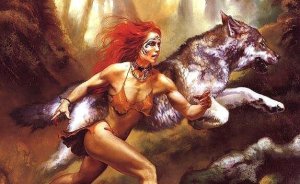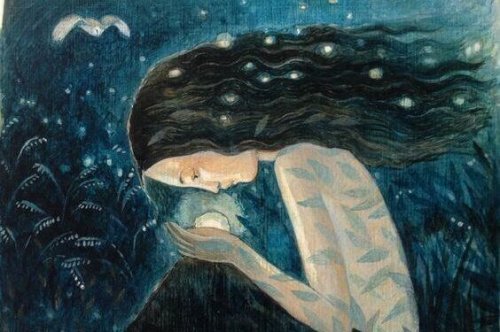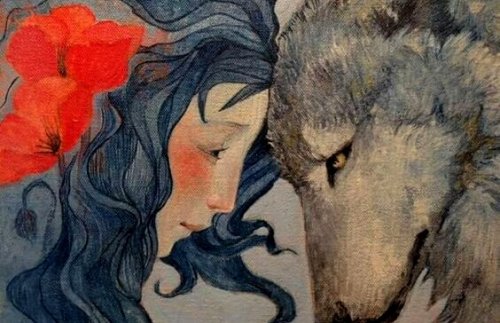Inside Every Woman Is a Wolf

The publication of the book Women Who Run With Wolves, by Clarissa Estes, seems to have ushered in a new female archetype: the wild woman. The book has been a wild success, with translations in 18 languages, several editions, and reprints. The interesting thing about the text is that it offers a magic and jubilant way of understanding feminism.
The basic premise of the book is that inside of every woman is a wild spirit, a wolf spirit. This spirit shelters vital and powerful energy that is born from the spontaneity of her natural way of being. This feminine animal is also fierce, she knows how to protect herself from predators and overcomes lack of experience or naïveté. The wolf is strong and knows how to show off her strength, even if it has been dormant for a long time.
“To love pleasure takes little. To love truly takes a hero who can manage his own fear.”
-Clarissa Estes-
The wolf is a misunderstood and stigmatized animal. Her wild side isn’t pure ferocity. She knows how to be the matriarch of her pack, she knows how to guide the others. She is capable of being the leader without fear or insecurity. She learns from her experiences and she knows how to take care of herself.
The wolf and modern women
Although modern women have made some incredible achievements and reached positions of power, they are a long way from their wild wolf essence. The Wild Woman doesn’t submit to commands like modern women do in advertising. Nor does she allow others to tell her what path to take. The Wild Woman is creative, passionate, instinctive, and wise.

Being a woman is a privilege. Nevertheless, our culture buries this fact. Sometimes women themselves bury it. The origin of our very civilization revolves around women. In the beginning, the only established blood ties were through women. Human groups congregated around mothers because not much was understood about paternity. Human society began with women at the center.
In the dawn of mankind, the “wild woman” had her place. Today, however, femininity has been devalued. Many women try to achieve autonomy by imitating men, but a wild woman isn’t male. She is a wild and determined female who appreciates her femininity.
In particular, a wild woman doesn’t let anyone have power over her body. She dances alone or with a partner. She embraces and holds those around her. She is joyful and connected to her instincts and desires. She doesn’t let anyone tell her what she should weigh, when she should have children, or how to act for the approval of others.
The challenge of the wolf
Our culture imposes stereotypes of the “good woman” and “bad woman”. The first is respectable, many judge her to be the perfect example of virtue. The bad woman, on the other hand, risks stability because she wants to advance and progress. That’s why many societies call these types of women “bitches” or “sluts” and even wolves. They are the ones who give people something to talk about. They cause scandal. Interestingly, the word “puta” (Spanish for “slut”) comes from the word “buzda”, which means wisdom.

Rome, which was the capital of the world, was founded by Romulus and Remus. These abandoned boys survived thanks to the wolf who breastfed them. In classic Rome, prostitutes were not women who offered 15 minutes of sex to the highest bidder.
In general, they were instructed in politics, astrology, math, and much more. They didn’t just offer sex, but also well-rounded company. They were great conversationalists. The concept was similar to that of the geishas. This might give the idea that a wild woman is similar to a prostitute, but that isn’t the case.
The wild woman doesn’t demand, she offers. She doesn’t ask, she gives. In spite of this, she isn’t domesticated. If she acts this way it is because she feels powerful, not because she is submitting. She knows she can leave any day, without having to choose a destination. She knows she belongs to herself, which is why she can dedicate herself to other things. She’s not afraid of giving herself to someone else because she is free. She’s not afraid of suffering because she knows she is strong.
The wild woman is a great friend. She is loyal and protective. She is also very spiritual: she orients her life towards universal values and not end-of-the-month goals. She loves art because it is the best avenue of free expression. She loves herself, without being narcissistic or egotistical. The best part of all is that this wild wolf is inside every woman. All she has to do is gather the courage to wake it up.
The publication of the book Women Who Run With Wolves, by Clarissa Estes, seems to have ushered in a new female archetype: the wild woman. The book has been a wild success, with translations in 18 languages, several editions, and reprints. The interesting thing about the text is that it offers a magic and jubilant way of understanding feminism.
The basic premise of the book is that inside of every woman is a wild spirit, a wolf spirit. This spirit shelters vital and powerful energy that is born from the spontaneity of her natural way of being. This feminine animal is also fierce, she knows how to protect herself from predators and overcomes lack of experience or naïveté. The wolf is strong and knows how to show off her strength, even if it has been dormant for a long time.
“To love pleasure takes little. To love truly takes a hero who can manage his own fear.”
-Clarissa Estes-
The wolf is a misunderstood and stigmatized animal. Her wild side isn’t pure ferocity. She knows how to be the matriarch of her pack, she knows how to guide the others. She is capable of being the leader without fear or insecurity. She learns from her experiences and she knows how to take care of herself.
The wolf and modern women
Although modern women have made some incredible achievements and reached positions of power, they are a long way from their wild wolf essence. The Wild Woman doesn’t submit to commands like modern women do in advertising. Nor does she allow others to tell her what path to take. The Wild Woman is creative, passionate, instinctive, and wise.

Being a woman is a privilege. Nevertheless, our culture buries this fact. Sometimes women themselves bury it. The origin of our very civilization revolves around women. In the beginning, the only established blood ties were through women. Human groups congregated around mothers because not much was understood about paternity. Human society began with women at the center.
In the dawn of mankind, the “wild woman” had her place. Today, however, femininity has been devalued. Many women try to achieve autonomy by imitating men, but a wild woman isn’t male. She is a wild and determined female who appreciates her femininity.
In particular, a wild woman doesn’t let anyone have power over her body. She dances alone or with a partner. She embraces and holds those around her. She is joyful and connected to her instincts and desires. She doesn’t let anyone tell her what she should weigh, when she should have children, or how to act for the approval of others.
The challenge of the wolf
Our culture imposes stereotypes of the “good woman” and “bad woman”. The first is respectable, many judge her to be the perfect example of virtue. The bad woman, on the other hand, risks stability because she wants to advance and progress. That’s why many societies call these types of women “bitches” or “sluts” and even wolves. They are the ones who give people something to talk about. They cause scandal. Interestingly, the word “puta” (Spanish for “slut”) comes from the word “buzda”, which means wisdom.

Rome, which was the capital of the world, was founded by Romulus and Remus. These abandoned boys survived thanks to the wolf who breastfed them. In classic Rome, prostitutes were not women who offered 15 minutes of sex to the highest bidder.
In general, they were instructed in politics, astrology, math, and much more. They didn’t just offer sex, but also well-rounded company. They were great conversationalists. The concept was similar to that of the geishas. This might give the idea that a wild woman is similar to a prostitute, but that isn’t the case.
The wild woman doesn’t demand, she offers. She doesn’t ask, she gives. In spite of this, she isn’t domesticated. If she acts this way it is because she feels powerful, not because she is submitting. She knows she can leave any day, without having to choose a destination. She knows she belongs to herself, which is why she can dedicate herself to other things. She’s not afraid of giving herself to someone else because she is free. She’s not afraid of suffering because she knows she is strong.
The wild woman is a great friend. She is loyal and protective. She is also very spiritual: she orients her life towards universal values and not end-of-the-month goals. She loves art because it is the best avenue of free expression. She loves herself, without being narcissistic or egotistical. The best part of all is that this wild wolf is inside every woman. All she has to do is gather the courage to wake it up.
All cited sources were thoroughly reviewed by our team to ensure their quality, reliability, currency, and validity. The bibliography of this article was considered reliable and of academic or scientific accuracy.
- Pinkola. Estes, Clarissa (2009) Mujeres que corren con lobos. Madrid: Zeta Bolsillo
This text is provided for informational purposes only and does not replace consultation with a professional. If in doubt, consult your specialist.







